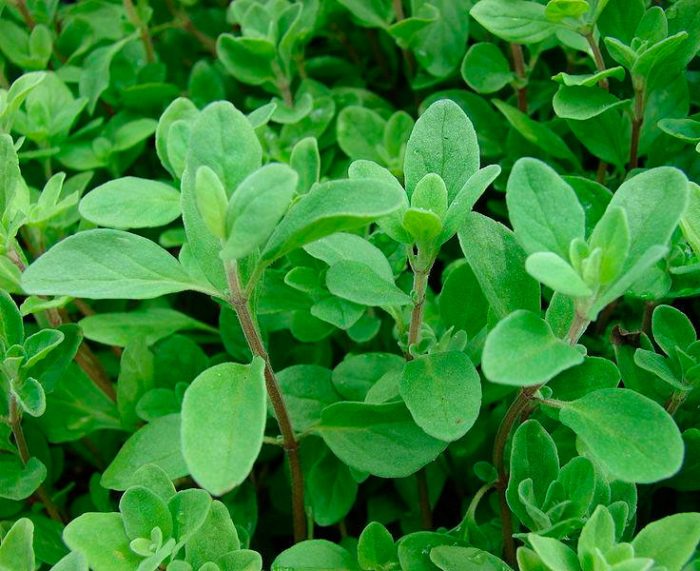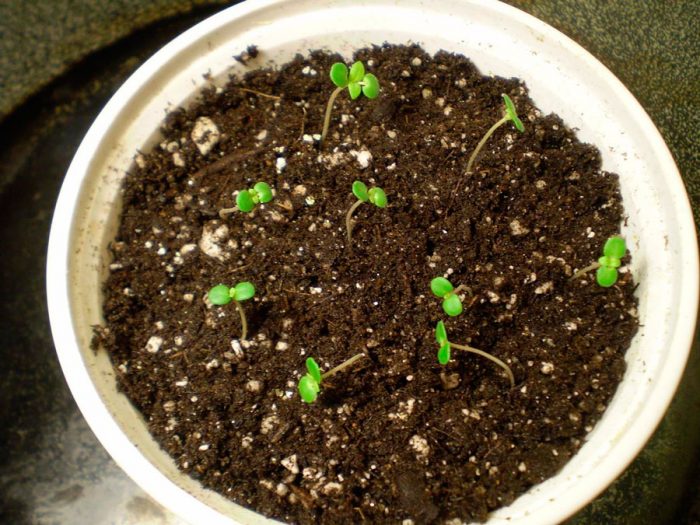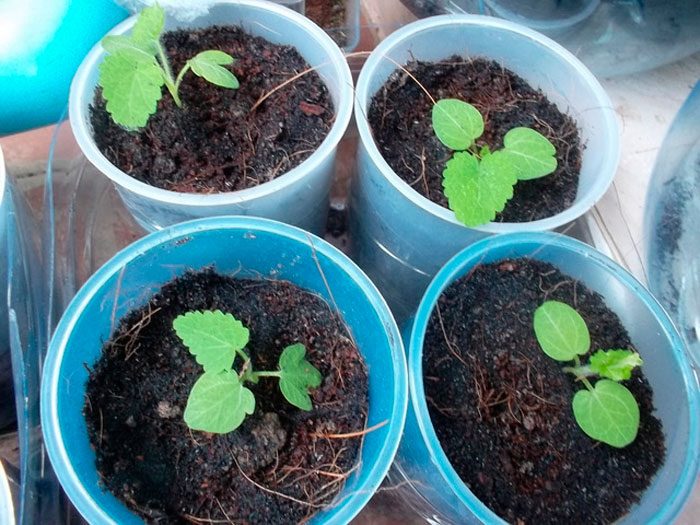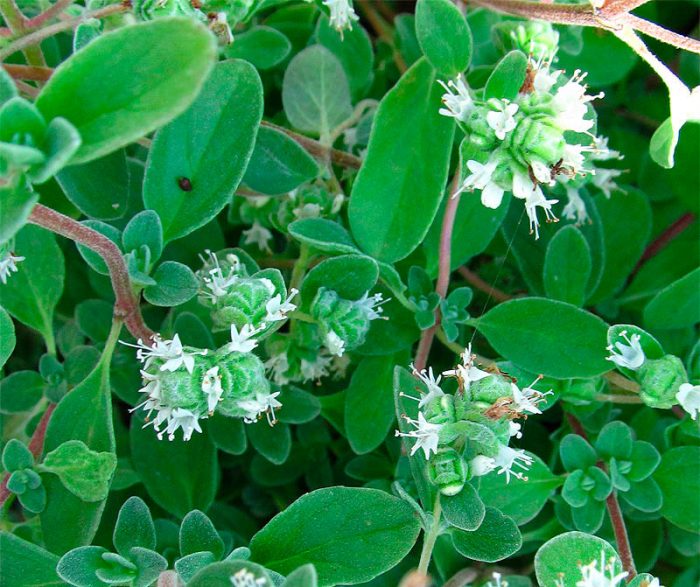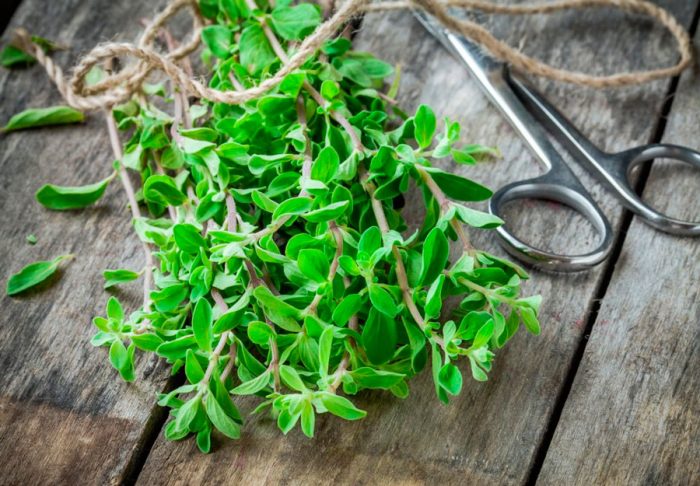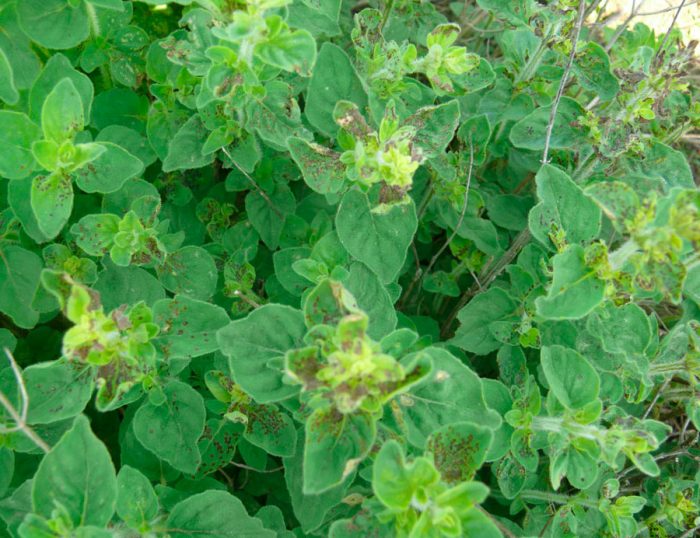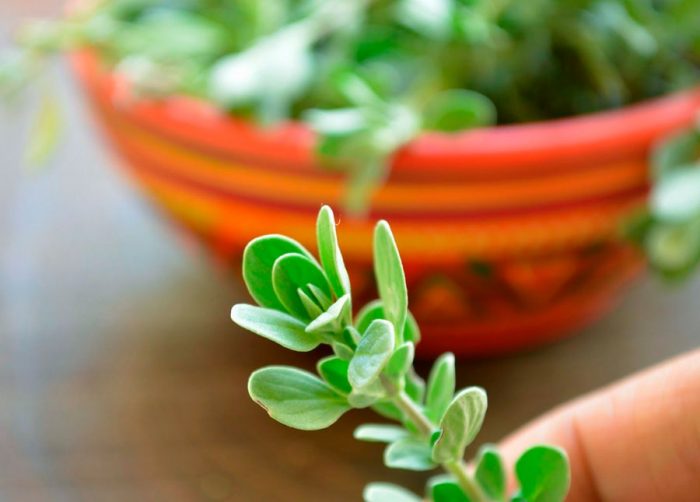A herbaceous perennial plant, marjoram (Origanum majorana) is a member of the Oregano genus of the Lamb family. In the wild, such a plant is found in North Africa, Central Europe and the Middle East. This herb was grown in Ancient Egypt, the Roman Empire and Hellas as a medicinal, decorative and spicy plant. The Greeks believed that marjoram possesses magical powers capable of returning love and courage to a person, they believed that such a herb received the smell from the goddess of love Aphrodite, in this regard, the newlyweds decorated their heads with marjoram wreaths. The Romans believed that this plant is a powerful aphrodisiac. Today the spicy herb marjoram is used in all countries as an additive to first courses, vegetables, salads and fish. This herb is used both fresh and dried. This seasoning is used in the preparation of liqueurs, desserts, liqueurs, and also as a flavoring for vinegar and tea.
Content
Features of marjoram
The height of straight and branched shoots varies from 0.2 to 0.5 m, they have a gray-silver color. The stems are lignified at the base. The shape of obtuse whole-edged leaf plates is spatulate or oblong-ovate, they have petioles, both surfaces are gray-felt. Oblong inflorescences are also tomentose-furry, they include 3-5 sessile spike-shaped bundles of a round-ovoid shape. Corollas in small flowers are colored white, light red or pink. Flowering begins in July or August. The fruit is an ovoid smooth nutlet. As a rule, this perennial is cultivated by gardeners as an annual, which is called garden marjoram.
Growing marjoram from seeds
Sowing
Marjoram has very small seeds, so when sown in open soil there is a high probability that they will not germinate. In this regard, this spice is recommended to be grown through seedlings. Before starting sowing, the seed should be combined with dry sand in a ratio of 1: 5. Sowing is carried out in the first days of April, while the boxes need to be filled with a soil mixture consisting of turf and humus (2: 1), into which you need to pour crushed chalk. The soil mixture must be well moistened, after which grooves are made in it, the distance between which should be from 40 to 50 mm.It is necessary to deepen the seeds into the substrate only by 0.2–0.3 cm, while on top they are sprinkled with dry soil mixture through a sieve. The box on top must be covered with foil or glass, after which it is removed to a warm place (from 20 to 22 degrees). The first seedlings should appear in 15–20 days, after which the cover should be removed from the container, and the crops should be removed for 7 days in a cool place (from 12 to 16 degrees). After a week, the seedlings must be provided with the following temperature regime: at night from 14 to 16 degrees, and in the daytime - from 18 to 20 degrees.
Seedling care
After the seedlings appear, watering the seedlings must be done as needed, while taking into account that the substrate must be constantly moist. You should also regularly loosen the surface of the substrate. After 1 pair of true leaf plates are formed in the plants in the first days of May, they should be cut out according to the 6x6 or 5x5 centimeters scheme into a greenhouse or a warm greenhouse. There the marjoram will grow before transplanting into open soil. However, if the seedlings sprout rather rarely, then it will be possible to do without a pick. 10 days before transplanting the plants into open soil, you should start hardening them, for this you need to remove the film for a while every day. The duration of such a procedure should be increased gradually. The seedlings will be ready for planting when they can stay in the fresh air around the clock. During the hardening of the seedlings, it is also necessary to gradually reduce the number of waterings.
Planting marjoram in open ground
Planting marjoram seedlings in open soil is carried out after return spring frosts are left behind. Depending on the region, this time may fall on the last days of May or the first days of June. If you plant from 15 to 20 large and well-developed seedlings on 1 bed, then this amount is quite enough to provide the gardener with the necessary volume of flowers and foliage.
For landing, you need to choose a well-lit place, which must be protected from wind gusts and drafts.
Suitable soil
This plant is recommended to be grown on loamy or sandy loam soil, because it is well warmed up by the sun. It is best to plant marjoram in an area where potatoes were previously grown. At least half a month before planting marjoram in the garden, it is necessary to prepare the site. To do this, it must be dug to a depth of 20 centimeters, while 20 grams of urea, from 30 to 40 grams of superphosphate, half a bucket of compost or humus and 20 grams of potassium sulfate per 1 square meter of plot should be added to the soil. When the digging is completed, the site must be spilled with lukewarm water, while 5 liters are taken per 1 square meter.
Landing rules
Planting and caring for such a plant is not burdensome, but so that there are no problems with the plant, it is necessary to adhere to the rules of agricultural technology of this culture. The distance between seedlings should be from 15 to 20 centimeters, and the row spacing should be from 40 to 45 centimeters. Immediately before planting, the holes need to be watered abundantly, while first pouring 1 handful of compost connected to the soil into each one. Then the plants are planted, they need to be taken with a lump of earth, after which the holes must be filled with soil, which is well tamped. The planted plants need to be watered. After 15–20 days, the seedlings should be fully rooted after transplanting into open ground. The first days after planting, marjoram must be protected from direct sunlight, and it must also be watered systematically. After the plants take root in a new place, during one of the watering they will need to be fed with a solution of nitrate (15 grams of the substance are taken for 1 bucket of water), while 10 liters of nutrient mixture should go to 1 square meter of the garden.


Watch this video on YouTube
Marjoram care
When growing marjoram in open ground, it should be watered, weeded, loosened the surface of the beds in a timely manner, fed, and, if necessary, protected from diseases and harmful insects. It should be remembered that marjoram, like few garden crops, needs timely weeding and loosening of the soil, otherwise it will negatively affect its growth and development.
How to water
Despite the fact that marjoram is resistant to drought, it belongs to moisture-loving plants, in this regard, it needs to be watered regularly and often. Watering is carried out in the early morning or in the evening after sunset. It is forbidden to use cold water for this. Starting from the middle of the summer period, the number of waterings should be gradually reduced, while it will be necessary to moisten the soil only when a crust appears on its surface. When the bushes are watered, the surface of the site must be loosened.
Fertilizer
When 20 days have passed after transplanting marjoram into open soil, it will need to be fed with complex fertilizer. To do this, use a nutrient solution consisting of 15–20 grams of superphosphate, 10 grams of urea and the same amount of potassium salt (per 1 square meter of the plot). One feeding for this plant is quite enough for it to grow and develop normally.
Collection, drying and storage of marjoram
Marjoram is harvested 2 times per season, namely: in the last days of July and the first in August, as well as in September and early October. When collecting raw materials, the entire leafy part of the bush is cut off at a height of 60–80 mm from the surface of the site, using a very sharp knife for this. After that, the grass is washed and dried very well. To do this, it can be tied in bundles and hung in a well-ventilated and shaded place (under a canopy or in the attic) or laid out on shelves and racks, which must first be covered with paper. When the grass is completely dry, it should be sorted out, and injured or yellow foliage must be removed. Then the marjoram is thoroughly crushed to a powdery state and poured into glass jars, which must be sealed with a lid. The herb is stored in a dark place.
What to plant after marjoram
As a rule, the area where the leaf crops were grown is well suited for planting root crops: carrots, radishes, turnips and beets.
Diseases and pests of marjoram
While the marjoram is young and has not had time to get stronger, it can get sick with Alternaria. In the affected bush, growth stops, and specks form on its leaf plates. The disease develops actively in wet weather when the planting thickens. The diseased plant must be sprayed with a fungicide solution.
On such a plant, the larvae of the marjoram moth can settle, which feed on its foliage. To get rid of the larvae, the bush and the surface of the soil under it must be treated with an insecticidal solution.
Types and varieties of marjoram with photos and names
Today, gardeners cultivate only 2 types of marjoram: floral and leaf. Leafy appearance - the bush has a branched strong stem with lush leaves and a small number of flowers. In a flower species, the roots and stems are not as strong as in a leafy one, and its flowering is not distinguished by splendor. Both of these species are cultivated as a spice, decorative and medicinal plant. The most popular varieties are:
- Baikal... This variety is distinguished by its yield. The height of the bush is about 0.55 m, the flowers are white in color, and the small, smooth and fragrant leaf plates are painted green.
- Gourmet... This variety is among the most productive. Its ripening time is about 120 days. The height of the bush is about 0.6 m, fragrant smooth greenish leaf plates are oval in shape, there may be a wax coating on their surface.
- Tushinsky Semko... The ripening time of this Russian variety is from 130 to 140 days.Bushes are not very branched, as a rule, they have a purple color and silver pubescence. Plants lignify at the base. The shape of the leaf plates is oblong-pointed, and their edge is serrated. Oblong inflorescences are composed of white flowers. Before the plant blooms, foliage and shoots are used for food fresh, and when flowering begins - in dried form.
- Thermos... The height of straight stems is about 0.4 m, they have a gray-silver color. There is pubescence on the surface of small green leaf plates. White flowers are also quite small.
- Scandi... The height of the bush is about 0.6 m. Small, smooth and fragrant leaf plates are oval and green in color, there is no wax coating on their surface. The flowers are white.
Marjoram properties: harm and benefit
Useful properties of marjoram
It is in the flowering tops of marjoram that active biological substances are found. This herb contains zinc, manganese, pectins and flavonoids, phytoncides, vitamins A, C and P, and an essential oil enriched with terpineol, linalool and sabinene hydrates. Thanks to such a rich composition, this plant has the following healing properties:
- eliminates toothache, while it fights inflammation and makes gums and tooth enamel stronger;
- promotes the discharge of sputum in case of lung diseases;
- used during the treatment of gynecological diseases, for example, menstrual irregularities and reproductive function;
- promotes the acceleration of blood circulation and the formation of new blood cells;
- helps to improve the functioning of the digestive tract, while stimulating digestion, eliminating inflammation in the intestines and flatulence;
- has a diuretic effect and helps to eliminate inflammatory processes in the bladder area;
- good for insomnia.
Tea is prepared from this plant: for this, half a liter of freshly boiled water is combined with 2 tsp. dry or fresh marjoram flowers, the mixture is allowed to brew. Only 1 tbsp. this drink will help with migraines.
The ointment made on the basis of this plant is used for abrasions, rheumatism, sprains, bruises and a runny nose in infants. To make such a tool, you must combine 1 tsp. alcohol, dried marjoram and unsalted fresh cow butter. The resulting mass must be warmed up in a water bath for 10-15 minutes, then it should be filtered and wait until it cools down. If the baby has a runny nose, then with such a remedy it is necessary to lubricate his nose from the inside. And for sprains and rheumatism, the agent must be rubbed into the problem area.
The most valuable is the essential oil of this plant, which is a light yellow liquid with a warm and tart odor. With the systematic use of this remedy for aromatherapy, you can forget about the feeling of anxiety, nervousness for a long time, and also feel a surge of cheerfulness. This remedy will also help get rid of corns, warts and keratoses. To do this, you need to combine olive oil and a few drops of this essential oil, this mixture should be regularly smeared with problem areas. A few drops of this oil can be added to foot and hand cream, as a result, the skin becomes very soft and tender.


Watch this video on YouTube
Contraindications
When using a small amount of such a plant, even a very strong migraine disappears, but if an overdose occurs, the pain will become much stronger. It is better for pregnant women to refrain from the frequent use of large amounts of marjoram as a preparation or seasoning, because it contains phytoestrogens hormones. It is also better to refuse to use such a herb for people with increased blood clotting, suffering from thrombosis or thrombophlebitis.Children under 5 years old also do not need to give preparations based on marjoram, as well as dishes with this plant.


